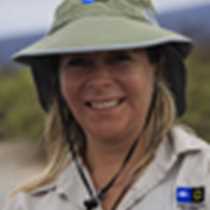Santa Cruz and North Seymour Islands
With a refreshing early wake up call, we started our second full day in the Galápagos. All of our guests were ready at 6:30 a.m after having a light breakfast in our main lounge to start disembarking for the visit to the high lands of Santa Cruz Island. We disembarked at the main dock in Puerto Ayora, and after a half hour ride on the main road crossing the island, we climbed off our buses to start our giant land tortoise search. We had already seen a couple of them on our way down to El Chato, two medium sized tortoises and two larger ones were seen on the road. But the big surprise was waiting for us! Two of the largest male tortoises wandering around the area were sighted and lots of pictures taken. Then another smaller one also showed up around the lagoon area. Some STOP signs have been placed on the trail by the GNPS to avoid guests wandering around the thick vegetation and getting lost!
We enjoyed and learned about these wild giant tortoises and all the efforts the Galápagos National Park Service (GNPS) is making to recuperate their numbers, which are very much diminished because of human predation. We started our way back to the main road to visit the large lava tunnels. Many of our guests took this interesting and different option, and there we were walking underground through the ancient tube used by a lava stream to run down towards the ocean.
After all these great experiences we had a big breakfast at the restaurant of a local farm; the view was just spectacular from up there. After all that we had done in the morning up in the highlands, we took our buses down into town and still had energy to shop and stroll along the main street on the shore of Puerto Ayora. We had a deserved lunch at noon on board the Islander.
In the afternoon after an interesting presentation by one of our naturalists on Charles Darwin’s life, we disembarked for a great adventure on a little island packed with strikingly wonderful wild life. We visited North Seymour where blue footed boobies, frigatebirds, land iguanas, marine iguanas, sea lions and more actually shared the trail with us! We walked around them, and they showed no fear. They seemed not even to notice our presence here. This is one of the peculiarities that good park and tourism management has retained in these islands.
The most striking sight we had this afternoon was the huge red balloons of courting male frigatebirds. We returned to the Islander around six in the afternoon after a full and exciting day. In the evening we had our recap and briefing, a delicious dinner, and a wonderful National Geographic film on the “Dragons of Galápagos.” Do you think that by now our guests were ready to go to bed?
With a refreshing early wake up call, we started our second full day in the Galápagos. All of our guests were ready at 6:30 a.m after having a light breakfast in our main lounge to start disembarking for the visit to the high lands of Santa Cruz Island. We disembarked at the main dock in Puerto Ayora, and after a half hour ride on the main road crossing the island, we climbed off our buses to start our giant land tortoise search. We had already seen a couple of them on our way down to El Chato, two medium sized tortoises and two larger ones were seen on the road. But the big surprise was waiting for us! Two of the largest male tortoises wandering around the area were sighted and lots of pictures taken. Then another smaller one also showed up around the lagoon area. Some STOP signs have been placed on the trail by the GNPS to avoid guests wandering around the thick vegetation and getting lost!
We enjoyed and learned about these wild giant tortoises and all the efforts the Galápagos National Park Service (GNPS) is making to recuperate their numbers, which are very much diminished because of human predation. We started our way back to the main road to visit the large lava tunnels. Many of our guests took this interesting and different option, and there we were walking underground through the ancient tube used by a lava stream to run down towards the ocean.
After all these great experiences we had a big breakfast at the restaurant of a local farm; the view was just spectacular from up there. After all that we had done in the morning up in the highlands, we took our buses down into town and still had energy to shop and stroll along the main street on the shore of Puerto Ayora. We had a deserved lunch at noon on board the Islander.
In the afternoon after an interesting presentation by one of our naturalists on Charles Darwin’s life, we disembarked for a great adventure on a little island packed with strikingly wonderful wild life. We visited North Seymour where blue footed boobies, frigatebirds, land iguanas, marine iguanas, sea lions and more actually shared the trail with us! We walked around them, and they showed no fear. They seemed not even to notice our presence here. This is one of the peculiarities that good park and tourism management has retained in these islands.
The most striking sight we had this afternoon was the huge red balloons of courting male frigatebirds. We returned to the Islander around six in the afternoon after a full and exciting day. In the evening we had our recap and briefing, a delicious dinner, and a wonderful National Geographic film on the “Dragons of Galápagos.” Do you think that by now our guests were ready to go to bed?




